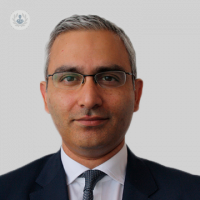Understanding knee preservation surgery: A less invasive path to knee health
Written by:In his latest online article, Mr Tahir Mahmud gives us his insights into knee preservation surgery. He talks about what knee preservation surgery is and how it differs from traditional knee replacement surgery, the most common knee conditions or injuries that would benefit from this procedure, the recovery process and the risks and complications.

What's preservation surgery of the knee and how it does this defer from a traditional knee replacement surgery?
Knee preservation surgery aims to retain as much of the patient's natural knee as possible, postponing the need for artificial knee replacement until it's essential. The initial approach typically involves an arthroscopy, a minimally invasive keyhole procedure. During this, damaged cartilage, known as meniscus, can be repaired, loose joint fragments stabilised (chondroplasty), and loose bodies removed. These interventions improve the knee's condition, providing additional function and relief from pain.
If severe arthritis affects only one side of the knee, a compartmental analogy can be made to a three-wheeled car. In such cases, preserving the knee might involve either a partial knee replacement, replacing only the damaged section, or an osteotomy, a procedure that realigns the knee joint to shift weight-bearing stress away from the damaged area. These knee-preserving procedures can be effective in alleviating pain caused by significant osteoarthritis and are seen as intermediate steps before considering a total knee replacement.
Essentially, these less invasive procedures help restore function, manage pain, and improve the patient's quality of life until the knee further deteriorates or other areas of the knee sustain damage, necessitating a total knee replacement.
Which would be the most common knee conditions or injuries that will benefit from this procedure?
Patients who might be candidates for these knee-preserving procedures typically fall within a specific profile. They are often younger individuals, typically in their mid-40s to early 50s, who have a history of high activity levels and sports engagement. In their youth, they may have experienced sports-related injuries, such as a meniscal tear in their late teens or early 20s. In some cases, a substantial portion of their meniscus, which acts as a shock absorber for the knee, may have been surgically removed, leading to premature thinning of the joint surfaces. This can result in osteoarthritis, a condition usually associated with older individuals.
Osteoarthritis in these younger patients can be extremely painful and significantly impact their quality of life, limiting their ability to exercise, maintain an active lifestyle, or participate in sports and activities with their family, including their children. For these individuals, the goal is to find knee-preserving techniques that can help them regain a high quality of life while avoiding the need for a highly invasive or aggressive procedure like a total knee replacement. This is especially important because younger patients often have higher expectations regarding the functionality and performance of their knees.
What is the expected recovery process for this type of surgery, and how does it differ in terms of timing compared to a traditional knee replacement?
The recovery period following either a partial knee replacement or, for instance, a high tibial osteotomy may vary. In both cases, the individual will require the use of crutches for a certain duration. However, recovery tends to be somewhat faster with a partial knee replacement because the individual can confidently bear full weight from the day of the surgery. Typically, swelling is less pronounced with a partial knee replacement compared to a high tibial osteotomy. It's important to note that these two procedures are distinct.
After the initial challenging phase with the osteotomy, at around six to eight weeks, both sets of patients tend to reach a similar stage in their recovery. By approximately three months, both groups of patients would likely have similar progress in terms of their ability to resume normal activities and their overall pain levels. However, there may be occasional instances where the recovery is slower and more prolonged with realignment surgery rather than a partial knee replacement, depending on the specific type of osteotomy performed.
It's worth noting that with the utilisation of robotic surgery, recovery following a partial knee replacement can be significantly expedited, with reduced post-operative pain and swelling. In fact, it can be remarkably swift, especially when performed with a robotic-assisted approach.
Are there any additional risks or complications associated with preservation surgery?
Each surgical procedure comes with its own distinct set of potential risks and complications. Regrettably, there is no surgery that is entirely devoid of risk. The primary additional risks associated with osteotomy surgery, in comparison to knee replacement surgery, are a slightly elevated likelihood of damaging a major nerve or artery. However, we employ specialised saws that are safer than conventional saw blades, thereby reducing the risk of harming critical structures.
When a bone is cut and a gap is created within it, the bone must undergo a healing process. Sometimes, bones may exhibit delayed or non-union, meaning that they heal more slowly than usual or, in some cases, not at all. This is a risk unique to osteotomy surgery and is not a concern in partial knee replacement procedures. Nevertheless, it's crucial to emphasise that the overall risk of any adverse events occurring during either of these procedures is very low.
Mr Tahir Mahmud is a distinguished orthopaedic surgeon with over 20 years of experience. You can schedule an appointment with Mr Mahmud on his Top Doctors profile.


